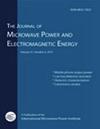Optimisation of Microwave-Assisted Extraction of Squalene from Amaranthus spp. Seeds
IF 0.9
4区 工程技术
Q4 ENGINEERING, CHEMICAL
Journal of Microwave Power and Electromagnetic Energy
Pub Date : 2019-10-02
DOI:10.1080/08327823.2019.1677429
引用次数: 6
Abstract
Abstract Squalene is a triterpene of pharmaceutical interest, due to its antioxidant and anticancer properties. Amaranth oil is a source of plant origin with high squalene content which is extracted by conventional methods that involve high cost, time-consuming and create large amounts of waste by-products or CO2 emissions. In this study, the microwave-assisted extraction (MAE) was used to obtain amaranth oil rich in squalene under closed conditions. The optimization of squalene yield (SQ) was conducted using response surface methodology by a Box-Behnken design (BBD) with 33 factors: time (20, 25, 30 min), solvent–co-solvent (50:50, 60:40, 70:30 v/v) and temperature (40, 60, 80 °C). The effect of factors on yield was measured by gas chromatography-mass spectrometry followed by a comparison of the yield and chemical composition than those obtained by Soxhlet extraction (n-hexane during 6 h). Optimal conditions produced a squalene yield of 16,456 mg·100g−1 oil versus 7,967 mg·100g−1 oil for conventional extraction. The ratio solvent and heating time significantly affected the yield, but the chemical composition and quality of extract were not affected, there were no oxidation products derived from the heat treatment. MAE has proven to be an environmental-friendly option with a significant reduction in time, energy and avoids solvent consumption.微波辅助提取苋籽角鲨烯的工艺优化
摘要角鲨烯是一种具有抗氧化和抗癌作用的三萜化合物。苋菜油是一种高角鲨烯含量的植物源,采用传统方法提取,成本高,耗时长,产生大量废物副产品或二氧化碳排放。在封闭条件下,采用微波辅助萃取法提取富含角鲨烯的苋菜油。采用Box-Behnken设计(BBD),采用响应面法对时间(20、25、30 min)、溶剂-助溶剂(50:50、60:40、70:30 v/v)和温度(40、60、80℃)33个因素对角鲨烯产率进行优化。采用气相色谱-质谱法测定各因素对产率的影响,并与索氏提取法(6 h内正己烷)的产率和化学成分进行比较。最佳提取条件下的角鲨烯得率为16,456 mg·100g−1,而常规提取条件下的角鲨烯得率为7,967 mg·100g−1。溶剂配比和加热时间对提取率有显著影响,但提取物的化学成分和质量不受影响,热处理后无氧化产物产生。MAE已被证明是一种环境友好的选择,可以显着减少时间,能源和避免溶剂消耗。
本文章由计算机程序翻译,如有差异,请以英文原文为准。
求助全文
约1分钟内获得全文
求助全文
来源期刊

Journal of Microwave Power and Electromagnetic Energy
ENGINEERING, CHEMICAL-ENGINEERING, ELECTRICAL & ELECTRONIC
CiteScore
2.50
自引率
6.70%
发文量
21
期刊介绍:
The Journal of the Microwave Power Energy (JMPEE) is a quarterly publication of the International Microwave Power Institute (IMPI), aimed to be one of the primary sources of the most reliable information in the arts and sciences of microwave and RF technology. JMPEE provides space to engineers and researchers for presenting papers about non-communication applications of microwave and RF, mostly industrial, scientific, medical and instrumentation. Topics include, but are not limited to: applications in materials science and nanotechnology, characterization of biological tissues, food industry applications, green chemistry, health and therapeutic applications, microwave chemistry, microwave processing of materials, soil remediation, and waste processing.
 求助内容:
求助内容: 应助结果提醒方式:
应助结果提醒方式:


